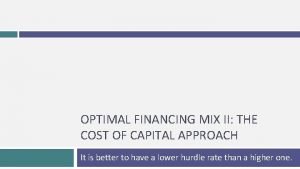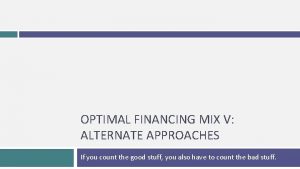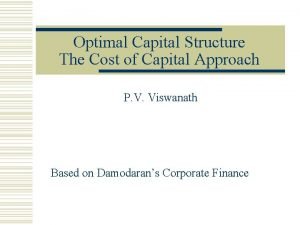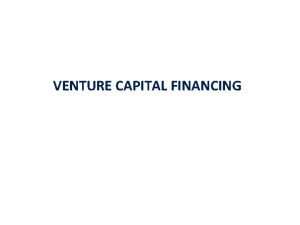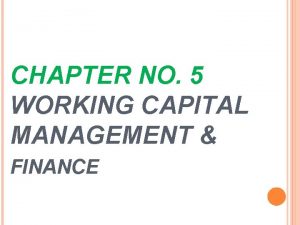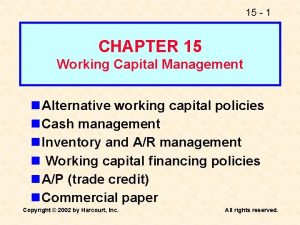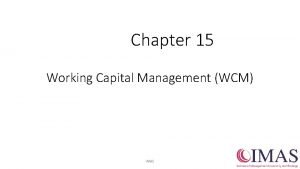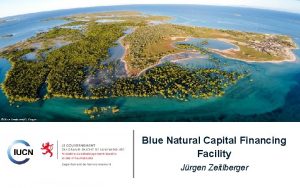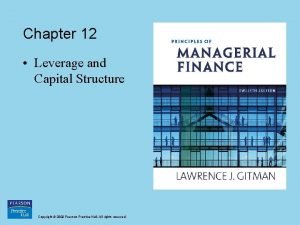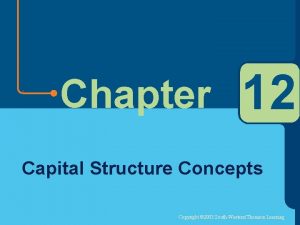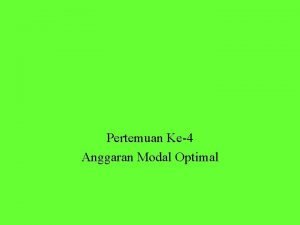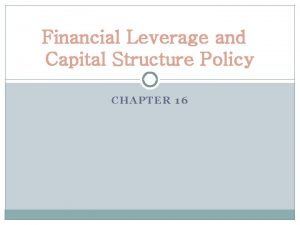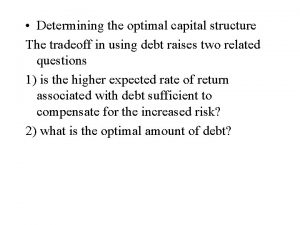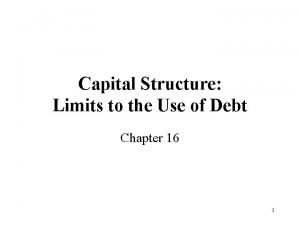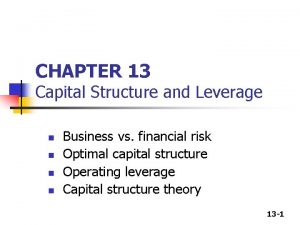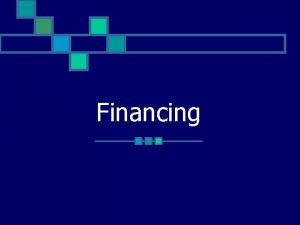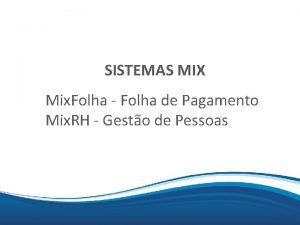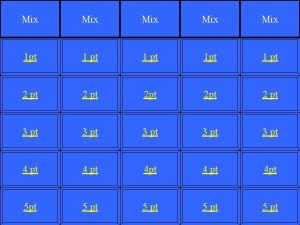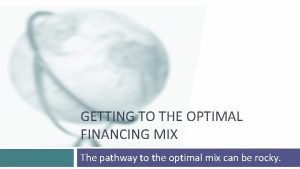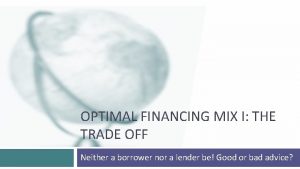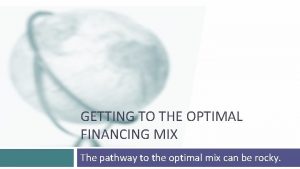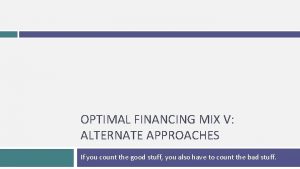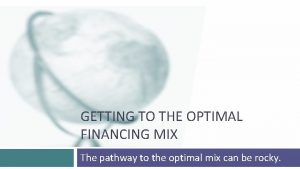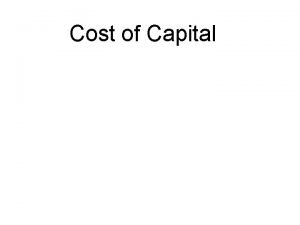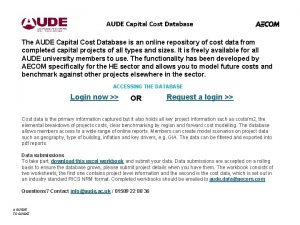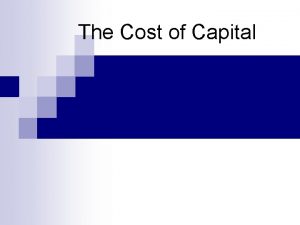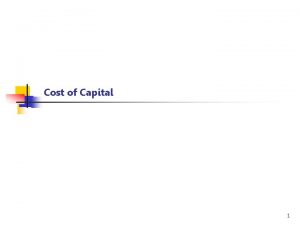OPTIMAL FINANCING MIX II THE COST OF CAPITAL



















- Slides: 19

OPTIMAL FINANCING MIX II: THE COST OF CAPITAL APPROACH It is better to have a lower hurdle rate than a higher one.


The Cost of Capital Approach Value of a Firm = Present Value of Cash Flows to the Firm, discounted back at the cost of capital. If the cash flows to the firm are held constant, and the cost of capital is minimized, the value of the firm will be maximized. 3

Applying Cost of Capital Approach: The Textbook Example 4

The U-shaped Cost of Capital Graph… 5

Current Cost of Capital: Disney The beta for Disney’s stock in November 2013 was 1. 0013. The T. bond rate at that time was 2. 75%. Using an estimated equity risk premium of 5. 76%, we estimated the cost of equity for Disney to be 8. 52%: Cost of Equity = 2. 75% + 1. 0013(5. 76%) = 8. 52% Disney’s bond rating in May 2009 was A, and based on this rating, the estimated pretax cost of debt for Disney is 3. 75%. Using a marginal tax rate of 36. 1, the after-tax cost of debt for Disney is 2. 40%. After-Tax Cost of Debt = 3. 75% (1 – 0. 361) = 2. 40% The cost of capital was calculated using these costs and the weights based on market values of equity (121, 878) and debt (15. 961): Cost of capital = 6

Mechanics of Cost of Capital Estimation 1. Estimate the Cost of Equity at different levels of debt: Equity will become riskier -> Beta will increase -> Cost of Equity will increase. Estimation will use levered beta calculation 2. Estimate the Cost of Debt at different levels of debt: Default risk will go up and bond ratings will go down as debt goes up -> Cost of Debt will increase. To estimating bond ratings, we will use the interest coverage ratio (EBIT/Interest expense) 3. Estimate the Cost of Capital at different levels of debt 4. Calculate the effect on Firm Value and Stock Price. 7

Laying the groundwork: 1. Estimate the unlevered beta for the firm One approach is to use the regression beta (1. 25) and then unlever, using the average debt to equity ratio (19. 44%) during the period of the. Unlevered beta = = 1. 25 / (1 + (1 - 0. 361)(0. 1944))= 1. 1119 Alternatively, we can back to the source and estimate it from the betas of the businesses. Revenues $20, 356 $14, 087 EV/Sales 3. 27 3. 24 Value of Business $66, 580 $45, 683 Studio Entertainment Consumer Products $5, 979 $3, 555 3. 05 0. 83 $18, 234 $2, 952 13. 49% 2. 18% Interactive $1, 064 1. 58 $1, 684 Disney Operations $45, 041 $135, 132 Business Media Networks Parks & Resorts Proportion of Unlevered beta Disney 49. 27% 1. 03 33. 81% 0. 70 Value $66, 579. 81 $45, 682. 80 Proportion 49. 27% 33. 81% 1. 10 0. 68 $18, 234. 27 $2, 951. 50 13. 49% 2. 18% 1. 25% 1. 22 $1, 683. 72 1. 25% 100. 00% 0. 9239 $135, 132. 11 100. 00% 8

2. Get Disney’s current financials… 9

I. Cost of Equity Levered Beta = 0. 9239 (1 + (1 -. 361) (D/E)) Cost of equity = 2. 75% + Levered beta * 5. 76% 10

Estimating Cost of Debt Start with the market value of the firm = = 121, 878 + $15, 961 = $137, 839 million D/(D+E) 0. 00% 10. 00% Debt to capital D/E 0. 00% 11. 11% D/E = 10/90 =. 1111 $ Debt $0 $13, 784 10% of $137, 839 EBITDA Depreciation $ 2, 485 EBIT Interest $12, 517 $ 2, 485 $10, 032 $0 $12, 517 Same as 0% debt $10, 032 Same as 0% debt $434 Pre-tax cost of debt * $ Debt Pre-tax Int. cov Likely Rating AAA Pre-tax cost of debt ∞ AAA 3. 15% 23. 10 EBIT/ Interest Expenses From Ratings table 3. 15% Riskless Rate + Spread 11

The Ratings Table Interest coverage ratio is > 8. 50 6. 5 – 8. 5 5. 5 – 6. 5 4. 25 – 5. 5 3 – 4. 25 2. 5 -3 2. 25 – 2. 5 2 – 2. 25 1. 75 -2 1. 5 – 1. 75 1. 25 -1. 5 0. 8 -1. 25 0. 65 – 0. 8 0. 2 – 0. 65 <0. 2 Rating is Aaa/AAA Aa 2/AA A 1/A+ A 2/A A 3/ABaa 2/BBB Ba 1/BB+ Ba 2/BB B 1/B+ B 2/B B 3/BCaa/CCC Ca 2/CC C 2/C D 2/D Spread is 0. 40% 0. 70% 0. 85% 1. 00% 1. 30% 2. 00% 3. 00% 4. 00% 5. 50% 6. 50% 7. 25% 8. 75% 9. 50% 10. 50% 12. 00% Interest rate 3. 15% 3. 45% 3. 60% 3. 75% 4. 05% 4. 75% 5. 75% 6. 75% 8. 25% 9. 25% 10. 00% 11. 50% 12. 25% 13. 25% 14. 75% T. Bond rate =2. 75% 12

A Test: Can you do the 30% level? 13

Bond Ratings, Cost of Debt and Debt Ratios 14

Stated versus Effective Tax Rates You need taxable income for interest to provide a tax savings. Note that the EBIT at Disney is $10, 032 million. As long as interest expenses are less than $10, 032 million, interest expenses remain fully tax-deductible and earn the 36. 1% tax benefit. At an 60% debt ratio, the interest expenses are $9, 511 million and the tax benefit is therefore 36. 1% of this amount. At a 70% debt ratio, however, the interest expenses balloon to $11, 096 million, which is greater than the EBIT of $10, 032 million. We consider the tax benefit on the interest expenses up to this amount: Maximum Tax Benefit = EBIT * Marginal Tax Rate = $10, 032 million * 0. 361 = $ 3, 622 million Adjusted Marginal Tax Rate = Maximum Tax Benefit/Interest Expenses = $3, 622/$11, 096 = 32. 64% 15

Disney’s cost of capital schedule… 16

Disney: Cost of Capital Chart 17

Disney: Cost of Capital Chart: 1997 18

Task Use the cost of capital approach to estimate the optimal financing mix for your company 19 Read Chapter 8
 Optimal financing mix
Optimal financing mix Optimal financing mix
Optimal financing mix Cost of capital
Cost of capital Multinational cost of capital and capital structure
Multinational cost of capital and capital structure Multinational cost of capital and capital structure
Multinational cost of capital and capital structure Stages of venture capital financing ppt
Stages of venture capital financing ppt Working capital cycle diagram
Working capital cycle diagram Capital financing requirement
Capital financing requirement Working capital financing policy
Working capital financing policy Ready imas
Ready imas Blue natural capital financing facility
Blue natural capital financing facility Optimal capital structure formula
Optimal capital structure formula How to calculate optimal capital structure
How to calculate optimal capital structure Anggaran modal
Anggaran modal Mm proposition ii with taxes
Mm proposition ii with taxes Determining optimal capital structure
Determining optimal capital structure Optimal capital structure
Optimal capital structure Types of product line
Types of product line Capital restructuring involves changing the ________ mix.
Capital restructuring involves changing the ________ mix. Gross working capital
Gross working capital
